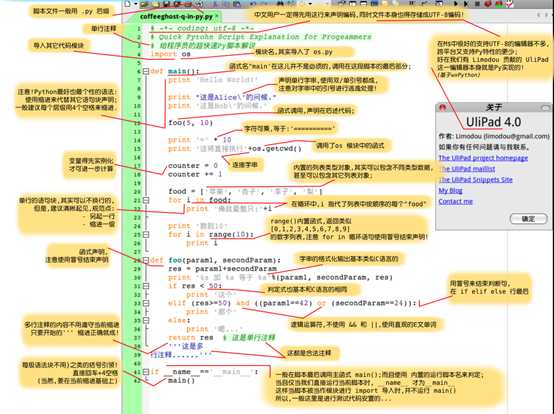标签:__init__ sage mode 缩进 pac 构造函数 options image 文件
Python标识符
在Python中,标识符由字母、下划线、数字组成。
在Python中,所有的标识符可以包括英文, 数字以及下划线(_),但是不能以数字开头。
Python中的标识符是区分大小写的。
以下划线开头的标识符是由特殊意义的。
l 以单下划线开头的 _foo 的代表不能直接访问的类属性,需通过类提供的接口进行访问,不能用 from xxx import * 而导入
l 以双下划线开头的 __foo 代表类的私有成员
l 以双下划线开头和结尾的 __foo__代表python里特殊方法专用的标识,如 __init__()代表类的构造函数。
Python可以同一行显示多条语句,方法是用分号 ; 分开
Python保留字符
保留字不能作为常量或变量,或其他任何标识符名称,所有Python的关键字只包含小写字母。
|
and |
exec |
not |
|
assert |
finally |
or |
|
break |
for |
pass |
|
class |
from |
|
|
continue |
global |
raise |
|
def |
if |
return |
|
del |
import |
try |
|
elif |
in |
while |
|
else |
is |
with |
|
except |
lambda |
yield |
行和缩进
python的代码块不使用大括号开控制类、函数以及其他逻辑判断。python最具有特色的就是用缩进来写模块
缩进的空白数量是可变得,但所有的代码块必须包含相同的缩进空白数量,这个必须严格执行。
建议在每个缩进层次使用单个制表符或两个空格或四个空格,切记不能混用。
多行语句
Python语句中一般以新行作为语句的结束符。
但是我们可以使用斜杠(\)将一行的语句分为多行显示
语句中包含[],{}或()就不需要使用多行连接符
python引号
Python可以使用引号、双引号、或三引号来表示字符串,引号的开始和结束必须是相同类型。
其中三引号可以由多行组成,编写多行文本的快捷语法,常用于文档字符串,在文件的特定地点,被当做注释。
Python注释
python中单行注释采用#开头
注释可以在语句或表达式行末
python中多行注释使用三个引号或三个双引号
Python空行
函数之间或类的方法之间用多行空行隔开,表示一段新的代码的开始。类和函数入口之间也用一行空行分隔,以突出函数入口的开始
空行和代码缩进不同,空行并不是Python语法的与部分,书写时不插入空行,Python解释器运行也不会出错。但是空行的作用在于分隔两段不同的功能或含义的代码,以便日后代码的维护或重构。
空行也是程序代码的一部分。
等待用户输入:
下面的程序执行后就会等待用户输入,按回车键就会退出:
raw_input("enter is exit , and else is print : \n")
import sys; x = ‘runoob‘; sys.stdout.write(x+‘\n‘)
同一行显示多条语句:
Python可以在同一行中使用多条语句,语句之间使用分号分隔:
运行结果:
exbot@ubuntu:~/wangqinghe/python/20190819$ python mul.py
runoob
print输出:
print默认输出是换行的,如果要实现不换行需要在变量末尾加上逗号,
/*** print ***/ x = "a" y = "b" print x print y print "----------------" print x, print y, print x,y
运行结果:
exbot@ubuntu:~/wangqinghe/python/20190819$ python print.py
a
b
----------------
a b a b
多个语句构成代码组
缩进相同的一组语句构成一个代码块,我们称之为代码组。
像if、while、def、和class这样的复合语句,首先以关键字开始,以冒号结束,该行之后的一行或多行代码构成代码组。
我们将首行以及后面的代码组称之为一个自居(clause)
命令行参数:
Python可以使用-h参数来查看各参数帮助信息:
exbot@ubuntu:~/wangqinghe/python/20190819$ python -h
usage: python [option] ... [-c cmd | -m mod | file | -] [arg] ...
Options and arguments (and corresponding environment variables):
-B : don‘t write .py[co] files on import; also PYTHONDONTWRITEBYTECODE=x
-c cmd : program passed in as string (terminates option list)
-d : debug output from parser; also PYTHONDEBUG=x
-E : ignore PYTHON* environment variables (such as PYTHONPATH)
-h : print this help message and exit (also --help)
-i : inspect interactively after running script; forces a prompt even
if stdin does not appear to be a terminal; also PYTHONINSPECT=x
-m mod : run library module as a script (terminates option list)
-O : optimize generated bytecode slightly; also PYTHONOPTIMIZE=x
-OO : remove doc-strings in addition to the -O optimizations
-R : use a pseudo-random salt to make hash() values of various types be
unpredictable between separate invocations of the interpreter, as
a defense against denial-of-service attacks
-Q arg : division options: -Qold (default), -Qwarn, -Qwarnall, -Qnew
-s : don‘t add user site directory to sys.path; also PYTHONNOUSERSITE
-S : don‘t imply ‘import site‘ on initialization
-t : issue warnings about inconsistent tab usage (-tt: issue errors)
-u : unbuffered binary stdout and stderr; also PYTHONUNBUFFERED=x
see man page for details on internal buffering relating to ‘-u‘
-v : verbose (trace import statements); also PYTHONVERBOSE=x
can be supplied multiple times to increase verbosity
-V : print the Python version number and exit (also --version)
-W arg : warning control; arg is action:message:category:module:lineno
also PYTHONWARNINGS=arg
-x : skip first line of source, allowing use of non-Unix forms of #!cmd
-3 : warn about Python 3.x incompatibilities that 2to3 cannot trivially fix
file : program read from script file
- : program read from stdin (default; interactive mode if a tty)
arg ...: arguments passed to program in sys.argv[1:]
Other environment variables:
PYTHONSTARTUP: file executed on interactive startup (no default)
PYTHONPATH : ‘:‘-separated list of directories prefixed to the
default module search path. The result is sys.path.
PYTHONHOME : alternate <prefix> directory (or <prefix>:<exec_prefix>).
The default module search path uses <prefix>/pythonX.X.
PYTHONCASEOK : ignore case in ‘import‘ statements (Windows).
PYTHONIOENCODING: Encoding[:errors] used for stdin/stdout/stderr.
PYTHONHASHSEED: if this variable is set to ‘random‘, the effect is the same
as specifying the -R option: a random value is used to seed the hashes of
str, bytes and datetime objects. It can also be set to an integer
in the range [0,4294967295] to get hash values with a predictable seed.
我们在使用脚本形式执行Python时,可以接受命令行输入的参数。
执行脚本传入参数,可以使用sys模块
/*** argv.py ***/ import sys print sys.argv
运行结果:
exbot@ubuntu:~/wangqinghe/python/20190819$ python argv.py hello
[‘argv.py‘, ‘hello‘]
python基本语法图:

标签:__init__ sage mode 缩进 pac 构造函数 options image 文件
原文地址:https://www.cnblogs.com/wanghao-boke/p/11376320.html